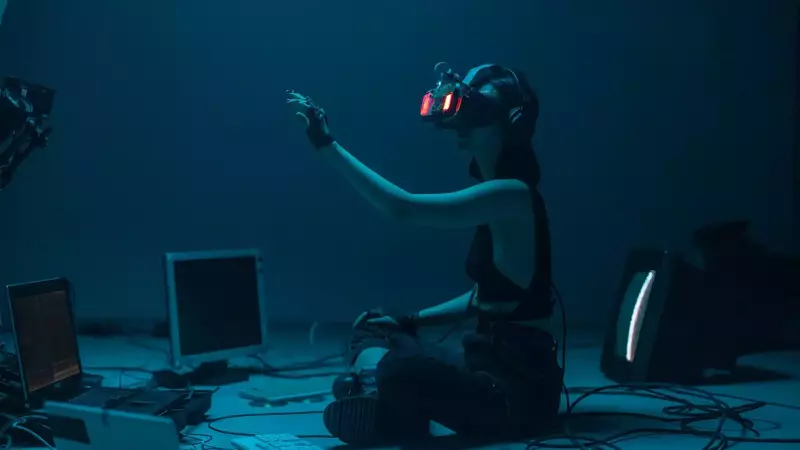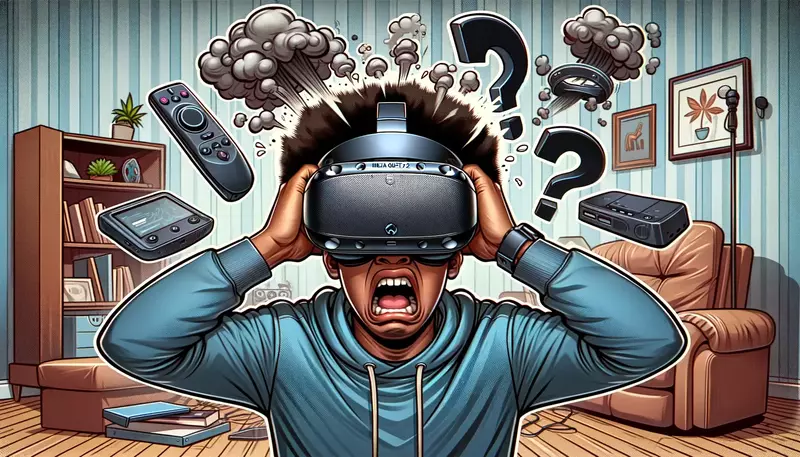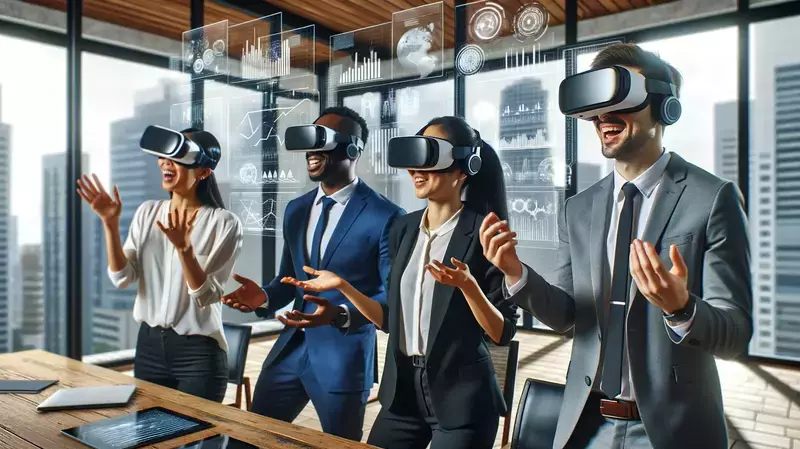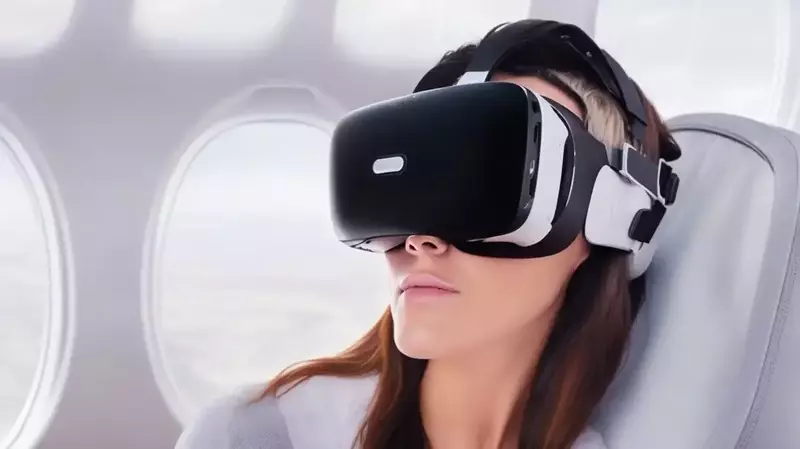This site contains affiliate links to products, and we may receive a commission for purchases made through these links.
Learning how to play VR on a PC opens up a world of immersive experiences and endless possibilities. VR has advanced drastically, with more lifelike visuals, interactive settings and an ever-expanding selection of titles that accommodate all sorts of tastes.
This blog post will guide you through the process of setting up your virtual playground on your computer.
We’ll start by discussing how to choose the right PC VR headset for your needs and preferences. Then we’ll walk you through setting up your system so it’s ready for action-packed virtual adventures. Next, we’ll cover finding and downloading the best PC VR games available today.
Once you’ve got everything set up, it’s time to dive into playing these incredible games in stunning virtual worlds. If any issues arise while learning how to play VR on a PC, don’t fret – we have included some troubleshooting tips to help.

1. Choosing the Right PC VR Headset
Selecting the ideal headset is vital for an enjoyable and engaging virtual reality gaming experience on your PC. When selecting a PC VR headset, various elements should be taken into account, including compatibility with your system, comfortability, and budget.
A. Types of PC VR Headsets
There are two main types of headsets available in the market:
- Tethered Headsets: These headsets connect directly to your computer via cables like HDMI or USB. Examples include the popular Oculus Rift S, and Valve’s high-end offering – the Valve Index.
- Standalone Wireless Headsets: These headsets do not require a connection to any external device since they have built-in computing power; however, some can be connected wirelessly using additional accessories for playing more demanding games from your computer library. The most notable example is Facebook’s Oculus Quest series (Quest 2 being their latest model).
B. System Compatibility & Requirements
Your chosen headset must be compatible with your existing hardware setup (PC/laptop). Each headset requires certain hardware specs that can be found on the maker’s site.
For example, you can check the Oculus Rift S system requirements or the Valve Index specifications.
C. Comfort & Ergonomics
Comfort is essential when it comes to VR gaming since you’ll likely be wearing your headset for extended periods. Look for headsets with adjustable straps, cushioning around the faceplate, and a balanced weight distribution to ensure comfort during long play sessions.
D. Price Range & Features
The price range of PC VR headsets varies significantly depending on their features and capabilities. Budget-friendly options like Oculus Rift S provide an excellent entry point into virtual reality gaming without breaking the bank.
However, if you’re looking for a more premium experience with advanced features such as finger-tracking controllers or wider field-of-view (FOV), consider investing in higher-end models like Valve Index.
Selecting the appropriate PC VR headgear is a crucial step to ensuring an excellent virtual reality experience. With the correct setup, you can now move on to setting up your PC VR system for optimal performance.
Selecting the correct headset is key to enjoying an immersive VR gaming experience on your PC. Tethered headsets like Oculus Rift S and Valve Index connect to your computer via cables while standalone wireless headsets like Oculus Quest 2 don’t require a connection to any external device but may need additional accessories for playing more demanding games from your computer library. Consider compatibility with your system, comfort, price range, and features when selecting a PC VR headset.
2. Setting Up Your PC VR System
In this section, we will guide you through the steps required to set up a PC VR system, including hardware and software requirements. Once you’ve carefully followed the instructions, you’ll be ready to enter a whole new realm of gaming and experience virtual reality firsthand.
A. Hardware Requirements
To enjoy an optimal experience with your chosen PC VR headset, it’s essential that your computer meets or exceeds certain hardware specifications:
- CPU: Intel Core i5-4590 / AMD Ryzen 5 1500X or better (depending on the headset)
- GPU: NVIDIA GTX 1060 / AMD Radeon RX 480 or better (again depending on the headset)
- RAM: At least 8GB DDR4 memory for smooth performance
- HDMI/DisplayPort: A compatible port for connecting your headset to your computer (check manufacturer guidelines)
B. Software Requirements and Installation
Your operating system should be updated to its latest version before installing any necessary software for your chosen VR platform.
- If using an Oculus Rift/Rift S or Quest connected via Link cable:
- Navigate to the official Oculus setup page and download the Oculus software.
- Follow the prompts presented on-screen to complete setup of your headset by connecting it to your PC.
- If using a HTC Vive or Valve Index:
- Create a free Steam account, if you don’t already have one, and install Steam on your computer.
- Navigate to the SteamVR page and click “Install” under “Play Game.”
Note that other headsets may require specific installation processes. Consult their respective manufacturer’s guidelines for more information.
C. Setting Up Your Play Area
To ensure an enjoyable and safe VR experience, it’s important to set up a dedicated play area with enough space for movement:
- Clear Space: Remove any obstacles from your designated play area (at least 6.5 x 5 feet).
- Sensor Placement: If using external sensors (such as those included with Rift S or HTC Vive), follow manufacturer guidelines for optimal placement around your play area.
After setting up your PC VR system, you are now ready to find and download the best PC VR games. To get started on this journey, let’s explore what types of games are available for your virtual reality experience.
Ensure that your computer meets the necessary requirements for an optimal experience, and set up a dedicated play area accordingly. It is important to ensure that your computer meets or exceeds certain specifications for an optimal experience, and to set up a dedicated play area with enough space for movement. Follow manufacturer guidelines carefully during installation processes.
3. Finding and Downloading PC VR Games
Finding the right games to play on your new PC VR system can be both exciting and overwhelming, given the vast array of options available.
In this section, we will guide you through some popular platforms where you can find and download compatible PC VR games for an immersive gaming experience.
A. SteamVR
SteamVR is one of the most popular platforms for finding and downloading a wide variety of virtual reality games for your PC. With its extensive library featuring thousands of titles across various genres, there’s something for everyone in SteamVR’s collection.
- To access SteamVR, first download and install the Steam client.
- Sign in to your existing account or create a free one to get started.
- Browse through their dedicated Virtual Reality category to discover new releases or search using specific keywords related to your interests.
- Purchase or download free-to-play titles directly from their store page by clicking “Add to Cart” or “Play Game.”
B. Oculus Store (for Oculus Rift users)
If you own an Oculus Rift headset, then exploring the exclusive content available on the officialOculus Store is highly recommended. The platform offers numerous high-quality experiences designed specifically for use with Oculus devices that may not be found elsewhere.
- Download and install theOculus app on your PC.
- Create an Oculus account or sign in with your Facebook credentials.
- Navigate to the Store section within the app and browse through their curated selection of games and experiences.
- Purchase or download free titles by clicking “Buy” or “Free.”
C. Viveport (for HTC Vive users)
Viveport is a platform designed specifically for HTC Vive owners, offering exclusive content as well as popular VR titles available across other platforms. With its subscription-based model, you can access a vast library of games at a reasonable monthly fee.
- Download and install theVIVE software.
- Create a VIVEPORT account or sign in using your existing credentials.
- Browse through their extensive catalog of VR experiences, either individually priced or included within their Infinity subscription plan.
Finding and downloading PC VR games can be a daunting task for many, but with the right resources it can become an enjoyable experience. Let’s progress to engaging with PC VR games.
This section provides guidance on finding and downloading PC VR games for an immersive gaming experience. SteamVR, Oculus Store (for Rift wearers) and Viveport (for HTC Vive players) are well-known marketplaces to look through a variety of VR games, with the option to purchase or obtain free titles directly from their store page by selecting “Add to Cart” or “Play Game.”
4. Playing PC VR Games
Now that your PC VR system is in place and prepared, you can plunge into the captivating realm of virtual reality gaming.
In this section, we will discuss how to play PC VR games effectively and provide tips for getting the most out of your experience.
A. Launching Your Game
To begin playing a game on your PC VR headset, first ensure that both the headset and any required controllers are connected properly.
Next, open your preferred VR platform or store, such as SteamVR or Oculus Home, and select the game you wish to play from your library.
Once launched, follow any in-game instructions for calibration or setup before diving into gameplay.
B. Familiarize Yourself with Controls
Each game may have its unique control scheme depending on whether it utilizes motion controllers or traditional input devices like a keyboard and mouse.
It is essential to familiarize yourself with these controls before starting gameplay so that you can navigate through menus easily and perform actions within the game smoothly.
- Motion Controllers: These allow players more natural interaction within their virtual environment by tracking hand movements accurately in real-time.
- Keyboard & Mouse: Some games still utilize traditional input methods but often include options for customizing keybindings based on personal preference.
- Haptic Feedback: Many modern headsets feature haptic feedback technology which provides tactile sensations corresponding with in-game events (e.g., feeling vibrations when firing a weapon).
C. Optimize Performance Settings
In order to get the best possible experience from your PC VR gaming, it’s crucial to optimize performance settings within both the game and your computer. This can include adjusting graphics quality, resolution scaling, or enabling/disabling certain features that may impact system resources.
- Graphics Quality: Lowering in-game graphics settings can help improve frame rates for smoother gameplay on lower-end systems.
- Resolution Scaling: Adjusting this setting will change the rendered resolution of the game while maintaining display size, potentially improving performance at the cost of visual clarity.
- Tweak Advanced Settings: Some games offer advanced options such as supersampling or anti-aliasing which can be adjusted to find a balance between image quality and performance based on individual hardware capabilities.
D. Ensure Comfort & Safety
To fully enjoy your PC VR gaming experience without interruption or discomfort, it is essential to take measures ensuring comfort and safety during play sessions.
These steps include proper headset adjustment, taking breaks when needed, and being aware of your surroundings in real-life space while immersed in virtual reality.
In conclusion,
Exploring virtual realms and savouring a new degree of immersion is an exhilarating way to enjoy PC VR gaming. Despite its potential for providing an immersive experience, PC VR systems can still be subject to various issues that must be addressed in order to maximize their capabilities.
The next heading will discuss troubleshooting common issues with PC VR systems.
This section provides tips for playing PC VR games effectively, including launching the game, familiarizing yourself with controls, optimizing performance settings and ensuring comfort and safety during play sessions. It is important to follow in-game instructions for calibration or setup before diving into gameplay and take measures to ensure comfort and safety while immersed in virtual reality.
5. Troubleshooting Common Issues with PC VR Systems
While playing PC VR games can be an immersive and exciting experience, it’s not uncommon to encounter some issues along the way.
This section looks at typical issues with PC VR systems and offers up solutions to address them.
5.1 Motion Sickness in Virtual Reality
Motion sickness is a common issue experienced by many users while playing virtual reality games. A discrepancy between what is visually perceived in the virtual world and how one’s body experiences motion can cause users to experience nausea when playing VR games.
- Solution: To minimize motion sickness, start by taking breaks frequently during gameplay sessions. Gradually increase playtime as you become more accustomed to the virtual environment.
- If you continue experiencing discomfort, try adjusting game settings such as reducing movement speed or turning off smooth locomotion features if available.
- You might also consider investing in an anti-motion sickness device like Relieband , which uses neuromodulation technology to help reduce symptoms of nausea related to motion sickness.
5.2 Laggy Performance or Frame Drops
Laggy performance or frame drops can significantly impact your enjoyment of a PC VR game and may even contribute to motion sickness symptoms mentioned above.
- Solution: First, ensure that your computer meets the minimum system requirements for running both the specific game and your chosen headset (refer back to Section 3).
- If lag persists despite meeting these requirements:
- A: Try lowering graphics settings within individual games’ options menus.B: Close any unnecessary background applications that may be consuming system resources.C: Ensure your computer’s hardware drivers, particularly graphics card drivers, are up-to-date. Visit the NVIDIA or AMD websites for the latest driver updates.
5.3 Tracking Issues with VR Controllers and Headsets
Inaccurate tracking of your headset or controllers can lead to a frustrating gaming experience as it hampers smooth interaction within the virtual environment.
- Solution: Begin by ensuring that all sensors and cameras required for your specific PC VR system are correctly set up and positioned according to manufacturer guidelines (refer back to Section 2).
- If tracking issues persist:
- A: Check for obstructions in front of sensors/cameras or reflective surfaces nearby which might interfere with tracking signals.B: Confirm that controller batteries have sufficient charge; low battery levels can impact performance.
Confirm that your controller is in good working order and has enough power; inadequate battery levels can lead to poor performance. By addressing these problems promptly, you’ll ensure smoother gameplay sessions and enjoy immersive virtual reality worlds without interruption.
This section offers troubleshooting tips for common difficulties encountered with PC VR, such as motion sickness, poor performance/frame rate dips and controller/headset tracking issues. To minimize motion sickness, take breaks frequently during gameplay sessions and adjust game settings if necessary. For laggy performance or frame drops, ensure your computer meets the minimum system requirements for running both the specific game and your chosen headset, lower graphics settings within individual games’ options menus, close any unnecessary background applications that may be consuming system resources and update hardware drivers regularly. Finally to solve tracking issues make sure all sensors are correctly set up according to manufacturer guidelines while checking obstructions in front of sensors/cameras or reflective surfaces nearby which might interfere with tracking signals is also important.
Frequently Asked Questions How to Play Vr on a Pc
How can I play VR on my PC?
To play VR on your PC, you need a compatible virtual reality headset, a powerful gaming computer with the required specifications, and appropriate software. Follow these steps: choose the right PC VR headset, set up your system by connecting all necessary hardware components, find and download VR games or applications from platforms like SteamVR or Oculus Store, launch the game using your preferred platform’s interface.
Can an RTX 3050 run VR?
An NVIDIA GeForce RTX 3050 is capable of running most virtual reality experiences but may struggle with more demanding titles. It meets minimum requirements for many popular headsets such as Oculus Rift S and HTC Vive. However, to ensure optimal performance in high-quality settings or advanced games/apps, consider upgrading to a higher-end GPU like an RTX 3060 Ti or above.
!! For more information about the different VR headsets on the market, check out this product specification list.
Final Thoughts
Exploring virtual reality games on a PC can be an exhilarating experience, transporting you to alternate realities and offering immersive gameplay. To begin, select a suitable PC VR headset, configure your system correctly, acquire and install games, and address regular problems.
With the steps outlined above, you can be ready to explore virtual reality gaming on your computer quickly. Remember to check for compatibility with your hardware before purchasing any VR equipment or software.
If you’re interested in learning more about how to play VR on a pc or want help setting up your system for optimal performance, visit Pursuit Meta. Our team of experienced professionals can assist you in selecting the best hardware and software for your VR setup.

Espen
Espen is the Director of PursuitMeta and has written extensively about Virtual Reality and VR Headsets for years. He is a consumer product expert and has personally tested VR Headsets for the last decade.




Leave a Reply